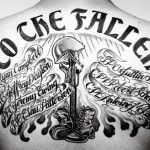U.S Army Tighten Up Tattoo Policy
Tattoos are arguably the most intense form of self-expression, statements permanently etched into one’s skin. But in the military, where everyone wears the same uniform, tattoos make individuals stand out, and now the Army is trying to make noticeable ink a thing of the past.
The U.S Army is undergoing a shake up on the rules enforced on its new recruits. When Sgt Major of the U.S Army, Raymond Chandler III visited troops in Afghanistan, he advised that stricter rules for grooming and appearance were due to be issued down the line in the near future. It seemed the new rules were in fact likely to be enforced within 30-60 days, leaving troops scrambling to get to the tattoo studio before the new guidelines came into place.
According to Stars and Stripes, a publication that reports on the U.S military, Chandler said new recruits may not have tattoos “that show below the elbows and knees or above the neckline.” As commanders used to say about spouses, if the Army wanted its soldiers to have portraits of their mother, girlfriend’s names or cartoons of Mickey Mouse on them, it would issue them.
Until now it has tolerated them, if the tattoos are not obscene, extremist, racist or gang-related, banning only those on the head, neck and face. Enforcement of the policy has varied, slackening at the height of the war in Iraq when the Army needed more soldiers. But now with the war in Iraq over and the one in Afghanistan winding down, the Army is poised to trim 80,000 troops in five years. With a smaller force, they can afford to be more selective, and after being promoted in 2011, Sergeant Major of the Army Raymond Chandler began speaking about a sterner tattoo policy. “The appearance of tattoos detracts from a uniformed service,” Chandler told soldiers at Fort Jackson, South Carolina last year, arguing that ink draws attention to the individual. “You are part of something larger.”
Existing members will be “grandfathered” but new recruits would need to remove any ink the newly deemed no-go areas. Tattoo shops have seen a dramatic increase in the number of soldiers rushing to get the ink they want before the new rules and guidelines are enforced. There has also been an increase in the number of prospective recruits wanting tattoo removal services.
Tavaris Brinson, 26, recently got his baby daughter’s name inked on to his forearm. When meeting with his military recruiter, the officer showed him a diagram of the human body with the parts that cannot be used as a canvas marked as off-limits. It originally cost Brinson $40 for the tattoo but he is now facing costs of at least $100 to have it removed so he can be accepted into the Army.
With the change, the Army will have the strictest tattoo policy of the four branches of service. The entire military prohibits racists, extremist or gang-related tattoos, but each branch has its own rules.
The Air Force has guidelines for “excessive” tattoos, meaning they cannot cover more than 25% of an exposed body part (like a forearm) when wearing any uniform. The Marines has separate rules for each department. Commissioned and warranted officers can only have four tattoos visible when wearing physical training uniform which consists of shorts and t-shirt. Enlisted marines can’t have tattoos on their hands, fingers, wrists or inside their mouths. Any tattoos visible in the physical training uniform cannot be larger than a fist.
